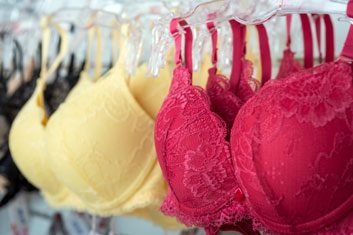Why You’re Probably Wearing a Bra That’s Too Small
A good bra is a key to our health, comfort and even our happiness – so why are so many women wearing the wrong size?

Today I decided to try out the kind of ‘bra’ most women had to wear throughout human history. So I wrapped a scarf around my chest and tied it at the back. The upside? No tugging at straps that slip down about 80 times an hour with my regular bra. The downside? My breasts look like two bombs pointing down to the centre of the earth.
Prior to the punishing invention of the iron corset, which must have been like walking around as if seized by the jaws of a shark, most epochs have featured women desperately trying to deal with their breasts by belting or banding them flat to their chests with strips of cloth. Sometimes they wore the bands under their breasts’like that would work’and sometimes over their dresses; in ancient Greece, they did a criss-cross thing that probably worked fine if you were a 28AA. Maybe more women were small-chested back then. We do know people were smaller in general, due to disease, malnutrition and lack of access to Cronuts. I’m certainly one of those women whose bra size rises with my weight.
In any event, if strips of linen were pretty much useless, the stays and corsets that began to be worn around the 13th century could only have made things worse. Our poor ancestresses had to wander about, trying not to faint, in straitjackets made variously of whalebone, wood, iron, starched linen or steel.
Finding a bra that’s comfortable and cute
We’ve come a long way, baby. And yet, and yet, we’re still trying to discover how to balance comfort, health and ever- changing ideas about beauty. I had the chance to talk about this recently with Jane Collins of London, Ont., who calls herself The Bra Lady. A gregarious 62-year-old with a warm smile, Collins is a ‘certified bra fitter’ who well knows what it’s like to wear the equivalent of a linen band; for years she’d scoured the stores for a bra that actually fit her.
Women come in every shape and size. ‘I see that every day now,’ she says. ‘I had never really looked at anyone else’s body before I started this work.’ About 15 years ago, she was at a women’s conference where they offered bra fittings. ‘The bras were functional, but not attractive. It was eye-opening.’ Once she was fitted to the contours of her own body, ‘I felt like, ‘Wow!’ I didn’t think I could find anything that made me feel so great.’ This set her on the path to getting certified as a bra fitter by Jeunique, a California-based company. She retired seven years ago from her job as a dispatcher at London Hydro, after a 34-year career there. She now holds bra-fitting clinics in towns around Ontario.
The bras she sells come in more than 200 subtly different sizes, ranging from 28A to 46KK. ‘A D cup is nothing!’ she pshaws. ‘I just fit a lady today who was a 34F; she came in thinking she was a 36D.’ Most women’s breasts will change in size seven times over their lives, Collins says, and when you turn 50, with all the hormonal changes’and resulting risk of weight gain”women will come in and say, ‘What’s happened to these things? They’ve gone berserk!”’ She laughs.
Those breasts need to find an undergarment that comes in something a little more nuanced than small, medium, or large‘the sizes offered when the bra was first patented. Here’s how that came about: The bra as we know it’something that distinguishes between and supports each breast’was developed in 1913 by an American woman named Mary Phelps Jacob, who sewed two silk handkerchiefs together and affixed ribbons for straps. You can just imagine how that would work out for the larger-breasted among us. Nevertheless, Warner Brothers Corset Company bought Phelps Jacob’s patent shortly after that, and by the ’30s, it had issued cup sizes: A, B, C and D.
Selecting from prefab sizes, around 70 percent of women end up with ill-fitting bras, says the Research Group in Breast Health (RGBH) at the University of Portsmouth in the U.K., which recommends investing in a properly fitting bra. ‘I find myself looking at women on the street,’ Collins agrees, ‘and I think, ‘They could use a bra fitting.’ I’d never say it out loud, of course.’
How the right-sized bra should really fit
A woman’s bra should fit her torso as well as her actual breast, with nipples at the midline of the cup. Breasts should be supported by the band below the cups, and all tissue ‘enclosed,’ as Collins puts it’nothing hanging out above, below or at the side. Says the RGBH, when we exercise, breasts bounce not just up and down but side to side and ‘backwards and forwards.’ Over time, without proper support, there is wear on the connective tissue, which causes pain.
The problem is that many of us have trouble considering bras in terms of our health. ‘Some women have a beautiful shape, yet they see their breasts as too big or too small,’ Collins says, lamenting that we’re being brainwashed by celeb culture. ‘It’s a terrible shame.’
Teen girls are particularly vulnerable, says Collins. ‘They want bigger breasts. But those heavily padded push-up bras are terrible! Some old gals who come to see me are in better shape than young women. The seniors wore proper bras in the ’50s, foundation garments. None of these flimsy things they sell now.’
Was there ever a moment of perfect balance? According to historian Valerie Steele in her book The Corset: A Cultural History, ‘A 1939 department store advertisement warned that ‘It can appear quite tempting on a hot summer’s day to take off one’s brassiere, but it is dangerous, very dangerous; only very few busts can do without the gentle support a brassiere can give.”’ That sounds ridiculous, but in the 1940s and ’50s, breast support was’at least temporarily’more important than sexy photo-ops.
Some bra manufacturers are interested in a return to that moment. Berlei Lingerie of Australia has been collaborating with the Biomechanics Unit at the Australian Institute of Sports to minimize breast bounce, which could lead to a new generation of cleverly constructed bras. It will be up to our daughters to be smart enough to wear them.
This article originally appeared in the May 2014 issue of Best Health. Subscribe today to get the full Best Health experience’and never miss an issue!




